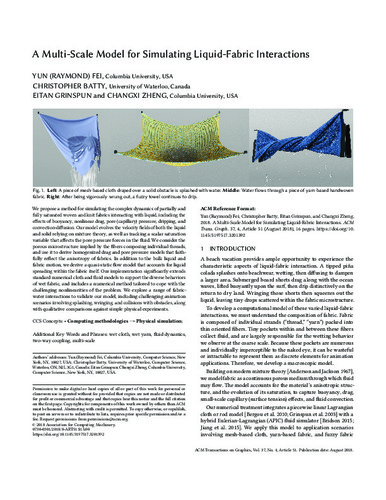| dc.contributor.author | Fei, Yun (Raymond) | |
| dc.contributor.author | Batty, Christopher | |
| dc.contributor.author | Grinspun, Eitan | |
| dc.contributor.author | Zheng, Changxi | |
| dc.date.accessioned | 2020-02-18 16:31:14 (GMT) | |
| dc.date.available | 2020-02-18 16:31:14 (GMT) | |
| dc.date.issued | 2018-07 | |
| dc.identifier.uri | https://doi.org/10.1145/3197517.3201392 | |
| dc.identifier.uri | http://hdl.handle.net/10012/15650 | |
| dc.description | Permission to make digital or hard copies of all or part of this work for personal or classroom use is granted without fee provided that copies are not made or distributed for profit or commercial advantage and that copies bear this notice and the full citation on the first page. Copyrights for components of this work owned by others than ACM must be honored. Abstracting with credit is permitted. To copy otherwise, or republish, to post on servers or to redistribute to lists, requires prior specific permission and/or a fee. Request permissions from permissions@acm.org | en |
| dc.description.abstract | We propose a method for simulating the complex dynamics of partially and fully saturated woven and knit fabrics interacting with liquid, including the effects of buoyancy, nonlinear drag, pore (capillary) pressure, dripping, and convection-diffusion. Our model evolves the velocity fields of both the liquid and solid relying on mixture theory, as well as tracking a scalar saturation variable that affects the pore pressure forces in the fluid. We consider the porous microstructure implied by the fibers composing individual threads, and use it to derive homogenized drag and pore pressure models that faithfully reflect the anisotropy of fabrics. In addition to the bulk liquid and fabric motion, we derive a quasi-static flow model that accounts for liquid spreading within the fabric itself. Our implementation significantly extends standard numerical cloth and fluid models to support the diverse behaviors of wet fabric, and includes a numerical method tailored to cope with the challenging nonlinearities of the problem. We explore a range of fabric-water interactions to validate our model, including challenging animation scenarios involving splashing, wringing, and collisions with obstacles, along with qualitative comparisons against simple physical experiments. | en |
| dc.description.sponsorship | This work was supported in part by the National Science Foundation under Grant Nos.: 1717178, 1319483, CAREER-1453101, the Natural Sciences and Engineering Research Council of Canada under Grant No. RGPIN-04360-2014, SoftBank Group, Pixar, and Adobe. | en |
| dc.language.iso | en | en |
| dc.publisher | ACM | en |
| dc.subject | wet cloth | en |
| dc.subject | wet yarn | en |
| dc.subject | fluid dynamics | en |
| dc.subject | two-way coupling | en |
| dc.subject | multi-scale | en |
| dc.title | A multi-scale model for simulating liquid-fabric interactions | en |
| dc.type | Article | en |
| dcterms.bibliographicCitation | Yun (Raymond) Fei, Christopher Batty, Eitan Grinspun, and Changxi Zheng. 2018. A Multi-Scale Model for Simulating Liquid-Fabric Interactions. ACM Trans. Graph. 37, 4, Article 51 (August 2018), 16 pages. https://doi.org/10.1145/3197517.3201392 | en |
| uws.contributor.affiliation1 | Faculty of Mathematics | en |
| uws.contributor.affiliation2 | David R. Cheriton School of Computer Science | en |
| uws.typeOfResource | Text | en |
| uws.peerReviewStatus | Reviewed | en |
| uws.scholarLevel | Faculty | en |

